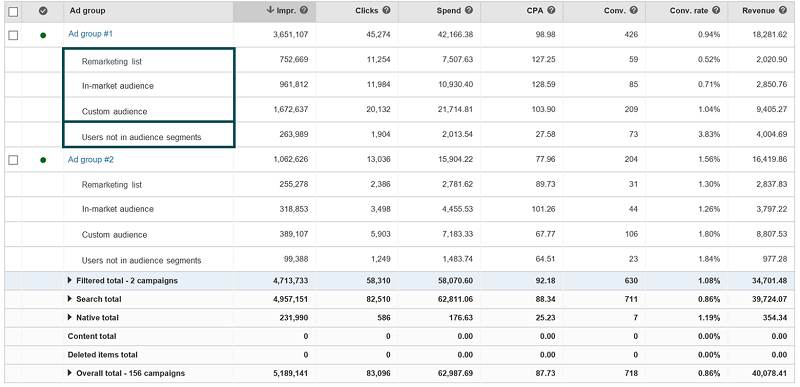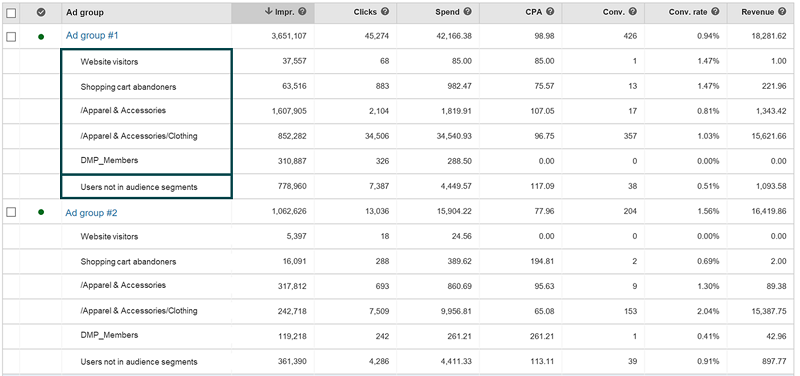Audience targeting reports at your fingertips
What if we could give you a way to review your audience performance in a single view, in less than a minute, and that was easy to export? Wish granted.
We’re excited to announce the launch of Audience Segmentation, a new addition to the Segmentation feature to help you easily get deeper insights into your audiences from Remarketing in Paid Search, In-market Audiences, and Custom Audiences. 1
Out with running multiple reports to stitch together the full picture of your audience targeting performance. In with robust audience reporting in a single view at the click of your mouse.
Let’s say you’re selling sport jerseys online. The big game is coming up and you want to reach people who are either ready to buy or are loyal customers. You’ve been focused on Remarketing in Paid Search to reach your loyal customers with good success and recently added In-Market Audiences to your existing campaigns, to reach people in the market for jerseys.
It’s been a couple of weeks and you want to know how it’s working out. Previously, to report on your audience performance you had to run Audience reports and Ad group reports and manually combine them, which took some time. Now with just a click of a button, you can see the performance lift of each audience against a common baseline of non-targeted users using the new “Audience Segmentation reporting.”
The data shows that both your Remarketing in Paid Search audiences and In-market audiences and have significantly out-performed users not in any audience segment. You may then decide to increase the bid boost appropriately for each of these lists in order to increase your Return on Ad Spend (ROAS).
This frees up your valuable time to focus on other important tasks – like watching the big game in your own jersey.
Start with the Audience category to view data grouped by audience targeting feature type. This will show you how Remarketing in Paid Search, In-market Audiences, Custom Audiences compare with one another – and to users not in segment.

A new row called Users not in audience segments is automatically created for you to view performance of those users not in any associated audience segments. Compare each of your audience category performance with User not in audience segments to identify which audience category is performing the best.

Then drill down by selecting Audience name to view performance of each audience to further analyze and identify top/poor performing audience within each category.

1In-market Audiences and Custom Audiences are pilot programs. If you’re interested in participating or learning more, please reach out to your Bing Ads account team.
2Based on Bing Ads analysis of Remarketing in Paid Search performance v. out of segment performance; Bing Ads Network, March 2017, US.
3Based on Bing Ads analysis of In-market Audience performance v. out of segment performance; Bing Ads Network, August - October 2017, US.
SEO Company in lucknow
We’re excited to announce the launch of Audience Segmentation, a new addition to the Segmentation feature to help you easily get deeper insights into your audiences from Remarketing in Paid Search, In-market Audiences, and Custom Audiences. 1
Out with running multiple reports to stitch together the full picture of your audience targeting performance. In with robust audience reporting in a single view at the click of your mouse.
Let’s say you’re selling sport jerseys online. The big game is coming up and you want to reach people who are either ready to buy or are loyal customers. You’ve been focused on Remarketing in Paid Search to reach your loyal customers with good success and recently added In-Market Audiences to your existing campaigns, to reach people in the market for jerseys.
It’s been a couple of weeks and you want to know how it’s working out. Previously, to report on your audience performance you had to run Audience reports and Ad group reports and manually combine them, which took some time. Now with just a click of a button, you can see the performance lift of each audience against a common baseline of non-targeted users using the new “Audience Segmentation reporting.”
The data shows that both your Remarketing in Paid Search audiences and In-market audiences and have significantly out-performed users not in any audience segment. You may then decide to increase the bid boost appropriately for each of these lists in order to increase your Return on Ad Spend (ROAS).
This frees up your valuable time to focus on other important tasks – like watching the big game in your own jersey.
Getting started with Audience Reporting via Audience Segmentation
The Audience Segmentation feature allows you to split your ad group performance data either by audience category or audience name to help you see how your ad groups are performing with Remarketing in Paid Search, In-market Audiences or Custom audiences - and compared to non-targeted users.Start with the Audience category to view data grouped by audience targeting feature type. This will show you how Remarketing in Paid Search, In-market Audiences, Custom Audiences compare with one another – and to users not in segment.

A new row called Users not in audience segments is automatically created for you to view performance of those users not in any associated audience segments. Compare each of your audience category performance with User not in audience segments to identify which audience category is performing the best.

Then drill down by selecting Audience name to view performance of each audience to further analyze and identify top/poor performing audience within each category.

Putting your audience performance insights into action
With this data in hand, you have a better idea on how your targeting strategy performs in action and can recognize new opportunities and areas for improvement. Here are a few areas to explore:- Increase your bid boosts for those audience segments with strong performance.
- If you’re using a 0% bid modifier or creating new associations, we recommend you start with 15% for Remarketing in Paid Search2 and 20% for In-market Audiences3 to harness the benefits of audience targeting.
- Expand your audience targeting coverage - associate your audience lists to additional ad groups, or if using In-market Audiences, identifying additional segments your business aligns with.
- Review and refine remarketing list definitions where performance is lower to ensure how you’ve defined the list is correct.
A few other things to note…
- As part of our global rollout, some customers will start seeing this feature today, and all customers will have this new feature by early February.
- The Audience Segmentation option is available on 6 tabs: Account Summary, Campaigns, Ad Groups, Ads, Keywords and Ad Extensions.
- You can download the data for offline manipulation through Download from the toolbar.
- The “Users not in audience segments” line item is only generated when audience data is available for the selected criteria (i.e. campaign, ad group).
- Data is available starting Jan 5, 2018 to use the Audience Segmentation feature; to report on your audience targeting performance prior you can utilize existing audience reports.
We want to hear from you!
You can always reach us on Twitter and our Feature Suggestion Forum with your ideas, comments, and suggestions.1In-market Audiences and Custom Audiences are pilot programs. If you’re interested in participating or learning more, please reach out to your Bing Ads account team.
2Based on Bing Ads analysis of Remarketing in Paid Search performance v. out of segment performance; Bing Ads Network, March 2017, US.
3Based on Bing Ads analysis of In-market Audience performance v. out of segment performance; Bing Ads Network, August - October 2017, US.
SEO Company in lucknow
Comments
Post a Comment